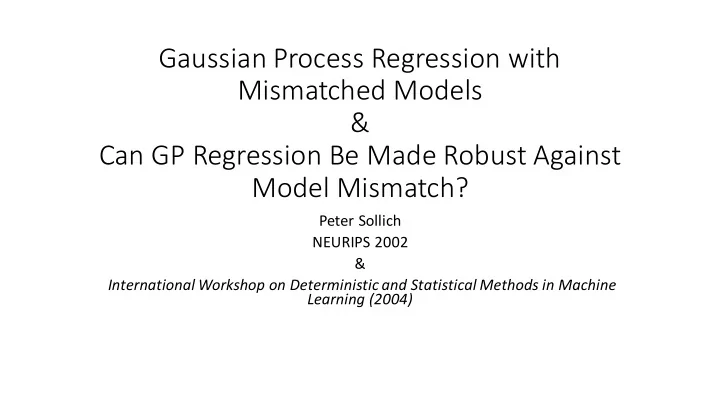

Gaussian Process Regression with Mismatched Models & Can GP Regression Be Made Robust Against Model Mismatch? Peter Sollich NEURIPS 2002 & International Workshop on Deterministic and Statistical Methods in Machine Learning (2004)
Learning curve Ideal learning curve: • Performance on true distribution • Average over multiple training datasets
What is GP regression? 𝑧 = 𝑔 𝑦 + 𝜗 , 𝜗~ 𝑂 0,𝜏 2 want to estimate 𝑔 Put a GP-prior on 𝑔 • 𝐷𝑝𝑤 𝑔 𝑦 𝑗 ,𝑔 𝑦 𝑘 = 𝐿(𝑦 𝑗 ,𝑦 𝑘 ) • 𝐹 𝑔 𝑦 = 0 Why GP-regression? • Posterior analytically (requires 𝑃(𝑜 3 ) ) • Error bars
Mismatched model? Input to GP: kernel 𝐿 , noise level 𝜏 • What if we use the wrong one? Setting: • Assume p(x) known: uniform on line or • Theory exact if 𝑒 = ∞ , otherwise all kinds hypercube • Assume K x, x ′ = g( 𝑦 − 𝑦 ′ ) of approximations
Weird learning curves • Plateaus or arbitrary # overfitting maxima Line 1D, noise level too low results in plateau Hypercube, d=10, noise level too small: 1e-4, 1e- 3, … true = 1
Asymptotic problems • No asymptotic decay 𝜗 = 𝑃( 𝑜 ) such as for parametric models, much 1 • If true kernel (OU, MB2) is less smooth than chosen kernel (RBF) slower (log. slow) • Prior cannot be overwhelmed by data (is too strong)
Fix? • But maybe we just chose very bad hyperparameters? • Maximize: 𝑄 𝐸 = ∫ 𝑄 𝐸 𝜄 𝑄 𝜄 𝑒𝜄 w.r.t. hyperpar. • A true Bayesian is too expensive… What if evidence maximization? • Setting: assume wrong kernel, but we tune 𝜏, 𝑏, 𝑚 using evidence • All kinds of approximations to make the analysis tractable…
Hypercube analysis • If we can tune par to get Bayes optimal performance, we will get it. • If we cannot find those par (for example, 𝑚 → ∞ ), convergence still very slow • No maxima’s • No experiments???
1D case • True kernel = MB2 • Used kernel = in plot • No maxima, plateaus • Optimal rate achieved
Recommend
More recommend